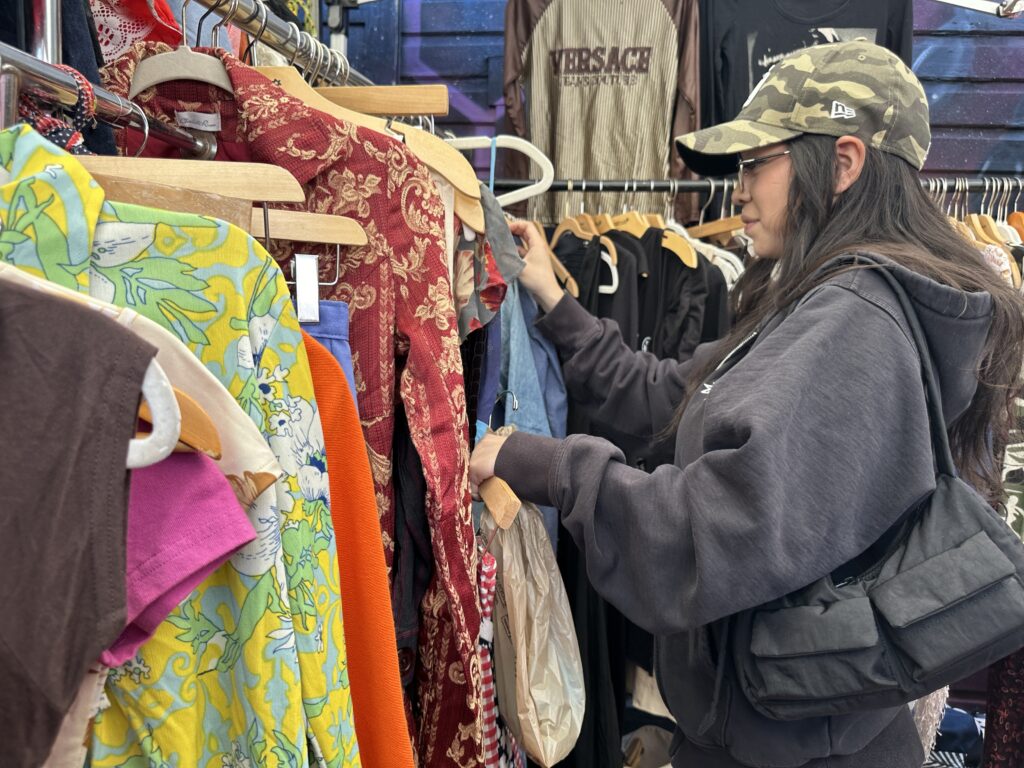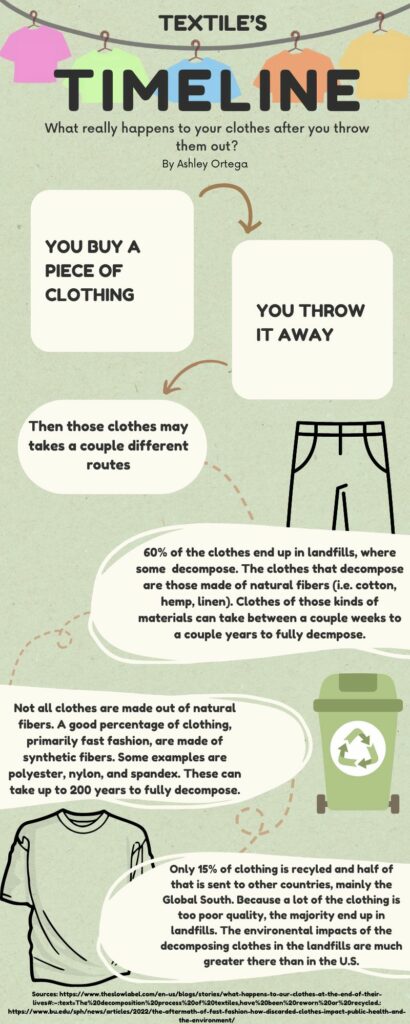Thrifting: The Trend that can alleviate the damage done by Fast Fashion
By: Ashley Ortega
May 3, 2024
With textile waste rising exponentially due to fast fashion and micro trends, thrifting has risen as a way to help combat this issue

San Diego, CALIF. – On average, the U.S. consumer throws away 81.5 lbs of clothes every year, according to Earth.org. Compared to 15 years ago, “the number of times a garment is worn has declined by around 36%.” What does this constant cycle of purchasing and discarding mean for the environment and how is buying secondhand clothing related to this textile waste?
What is Fast Fashion?
Fast fashion can be defined as cheap, trendy clothing of poor quality. According to Earth.org, it “refers to a large sector of the fashion industry whose business model relies on cheap and speedy production of low-quality clothing, which gets pumped quickly through stores in order to meet the latest and newest trends.”
To completely grasp fast fashion and why it’s become so prevalent, it’s important to understand what a “microtrend” is. According to TheCommons.Earth.com, “Microtrends are accelerated trends that last a month instead of a season.”
With the shelf-life of clothing being so quick, consumers feel the need to constantly buy the newest trend on the market. Isla Rindt, a collaborator with the Solana Center for Environmental Innovation, expressed her shock over the amount of textile waste produced, influencing her to make textile waste awareness her Girl Scout project.
“The reason I focused on it is because it’s an awareness issue and I think it’s continuing to get worse with social media and fast fashion and how fast trend cycles are now,” said Rindt. “There’s just higher rates than ever of buying stuff and discarding it.”
It’s easy to get wrapped up in fast fashion, especially as a surface-level enjoyer of fashion. According to Kimberly Lee, the creator of the vintage market Lucky Star, it isn’t until you delve more into that world, that you truly understand the detrimental effects of all this overconsumption.
“I didn’t know how bad fast fashion was and I bought a lot from Primark at the time, but I feel like that’s a normal thing for a fashion girl to go through,” said Lee. “ You go through fast fashion because you’re so excited about trying to figure things out.”
Buying from fast fashion brands like Shein, Primark, Cider, Forever 21, etc. sporadically isn’t the issue. The big issue is the constant purchasing of products and throwing them out to make room for more.
“ I don’t necessarily think the issue is buying a shirt or pants here and there from a brand like Shein, that’s a super fast fashion brand because a lot of people can’t afford to buy a super high-quality piece,” said Rindt. “I think the issue is the quantity mostly that a lot of people buy.”
The detrimental effects of Fast Fashion
To truly show how much fast fashion and textile waste effects the environment. Here’s an infographic informing on what exactly happens to your clothes after you throw them away.

Solana Center volunteer and community engagement lead, Elizabeth Davis, also expressed her feelings towards fast fashion. “The biggest word might be frustration,” said Davis.
She argues that fashion is one of the industries that consumers have more control over because this demand for new clothing that’s sprung over the past couple of years is an “artificial need”.
“It’s creating some of the worst waste and the worst toxicity because this is usually all very much synthetic petroleum-based,” said Davis.
In fact, the fast fashion industry accounts for about 10% of global carbon dioxide emissions. Waste doesn’t just occur at the end of the garment life cycle by throwing it away, there is “waste at every stage of the garment manufacturing process” according to facts posted on the Center for Biological Diversity’s website. This waste is responsible for “harming wildlife, degrading land, and polluting soil and water.”
“I don’t think a lot of people understand the scope of the problem,” said Davis.
An easy solution would just be to declare fashion in itself the problem and want to do away with the dependence on the industry in general, but it’s more complex than that.
“You could say that fashion, in general, is unnecessary, people could wear utilitarian clothing and all that. But it’s not in itself a bad thing to have trends, there’s a lot of artistic expressions, there’s a lot of social identities connected with how we dress and those things matter and are enriching, so when that means a little more use of resources I don’t think that’s necessarily a bad thing,” said Davis. The real problem lies in “creating a dissatisfaction where it wasn’t and the deliberate overproduction and then destruction of wearable garments so that people will buy the next thing.”
The biggest way people are fighting back against this problem is through buying secondhand clothing, also known as thrifting.
How Thrifting is helping

Shopping at thrift stores has always been around, but thrifting as a hobby started as a trend on social media sites like “TikTok.” Younger people began frequenting thrift stores and posting “thrift hauls” online.
According to online secondhand retailer Thredup in their yearly resale report, 65% of Gen Z and millennials shopped secondhand in 2023. In 2020, Thredup predicted that the secondhand market would reach $65 billion in 2024 and now it’s predicted to reach $230 billion by the end of the year. It also reported that by the year 2028, “the global secondhand market will reach $350 billion.”
“You get these staggering numbers of the millions and billions of clothing thrown away every year, well if people bought one less new piece and replaced that with finding something secondhand and wearing what they have for longer, each person wouldn’t have to do a lot for it have a huge impact,” said Davis. Apart from the environmental benefits of secondhand, it’s also a way for those in fashion to find more unique pieces that they wouldn’t find in newer clothing. This is one of the reasons Lee, the creator of Luck Stars market, started buying second-hand.
“I just fell more in love with vintage fashion because as a plus-sized person growing up my whole life, there are only so many options and I felt like I saw more unique things vintage-wise, so that’s why I started leaning more into vintage,” said Lee.
Her love for vintage fashion led her to create Lucky Stars, a monthly market that allows vendors to sell their products. A majority of these products are secondhand or vintage clothing. According to Lee, Lucky Stars is “like Etsy or Depop in real life, these people just have popups and they get to sell their art, jewelry, vintage clothing, or anything they want to sell.” Etsy is an online marketplace where small businesses sell their unique products and Depop is an online secondhand clothing retailer.
These markets are not a new concept, we’ve all visited flea markets and swap meets, but the thrift markets that have been rising in popularity feature a more fine-tuned selection than the random assortment you find at flea markets and swap meets.
According to ThriftCity.com , the advantages of thrifting are plenty. It helps “reduce waste, conserve resources, and minimize pollution.”
Gabrielle Houser, president of the San Diego State University Fashion Club and thrift market vendor, has been slowly trying to combat this overconsumption through both buying and selling secondhand clothing and bringing awareness through her club.
“I think social media is the biggest reason (for fast fashion) because microtrends are a much bigger thing now because people are seeing things on the internet so quickly,” said Houser.
Houser said she believes that buying from markets like these is a great alternative to fast fashion and while the impact might seem small, it is helping reduce waste. She tries to minimize her shopping and when she does she shops second-hand for herself and her store.
“I source only from GoodWill’s bins and hope that it keeps stuff out of landfills,” Houser said.
Thrift markets and thrifting in general also raise awareness for the textile waste issue, which is another way to combat this problem.
“I think it’s so important to educate people about that because it’s simply ignorance and not in a bad way it’s just something we’re not all taught to care about,” said Lee. “Vintage clothing is so much better quality too like there are benefits to vintage clothing, not just cute clothes, it’s so much deeper than that.”
Raising awareness is the route the Solana Center is taking when it comes to this issue. They recently had a “Taking on Textile Waste” event on March 23, led by Rindt and Davis, to educate the community on clothing and textile waste and its impact on the environment.
“It definitely starts with education because the more people that are interested the more there’s going to be a push to create legislation surrounding the issue,” said Rindt.
Learning about this issue can be overwhelming, but that is the first step in helping tackle the problem.
“When you first sort of pull back the lid on something like this it can be very discouraging or overwhelming but that’s normal and you’re one person,” said Davis. “Don’t let that stop you from making a start somewhere and do it in a way that feels most doable for you.”